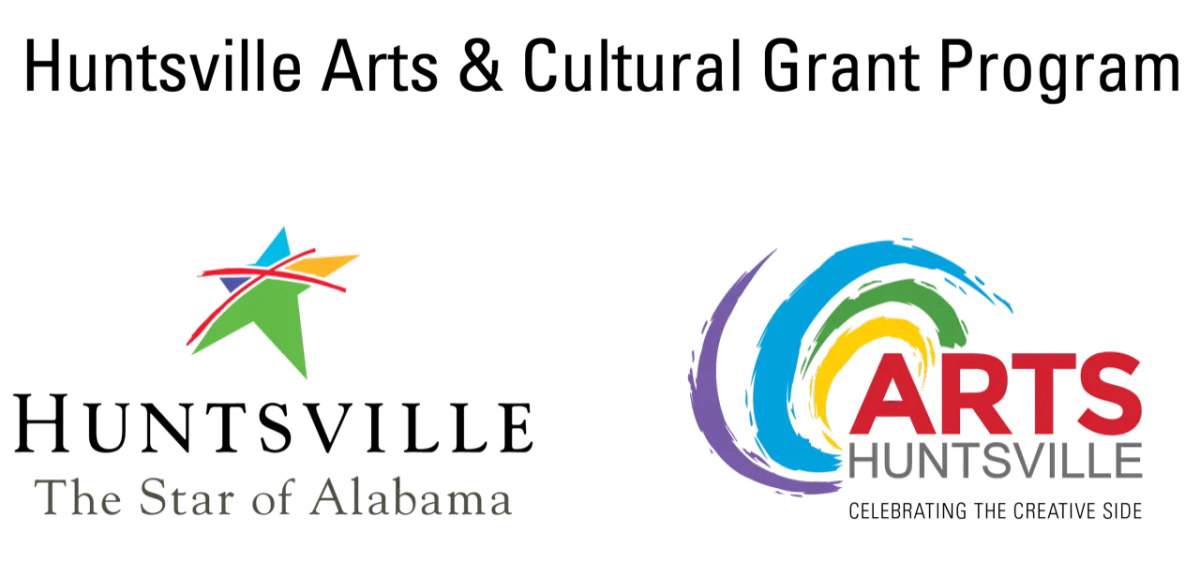HTMA History
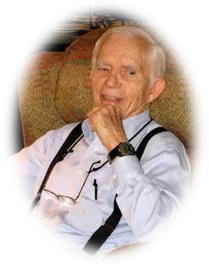
An updated History of the Huntsville Traditional Music Association
Revised in September 2022 by Jerry LeCroy, from Bill McCampbell’s original
From Bill McCampbell, written in 2001
When I, in a moment of weakness consented to working up a little history of the Huntsville Traditional Music Association, I thought it would be relatively simple to come up with a year-by-year account of major happenings--something that would be accurate but readable. I was wrong. First, nobody whom I know has records at all of the years since the founding of the old Huntsville Music Association, our parent organization.
As far as I know, I have the most nearly complete records since 1989, as well as the years 1980 and 1981. Memories of former associates seem to be conflicting, and I am not sure how accurate mine are.
So what I am left with is the prospect of some facts from newsletters an my notes and memories.. In essence, this will be mostly my memories and some fact. I must say this though: my memories of our current HTMA and the previous organizations are mostly pleasant ones. Sure, there have been some disappointments along the way, but more than offset by the happier times.
Enough of the bushwah. I will start now.
In nineteen seventy something, my wife gave me a mountain dulcimer. I could get some simple tunes on it, but wanted to learn more. I put an ad in the MARSHALL STAR to that effect and got a call from Sara Burcham telling me of a group called THE HUNTSVILLE ASSOCIATION OF FOLK MUSICIANS. That is, our old HAFM. It was indeed a fine organizations populated by some very fine musicians. I had found a home. It had been founded about 1966 by a group of amateur and professional musicians. Some were regulars at nights clubs etc. Some are still friends of HTMA, such as Terry and Sara Burcham and Bob and Kathy White. Most have gone to other interests and several are deceased, which, after over thirty years, is not surprising.
Before the group’s demise in the early eighties, members included:
Joe Gambill (dulcimer builder and musician par excellence), Bob Barnes; Bob and Kathy White, Aunt Bertha Robinson (great two-finger banjoist), Jim Johnson, Monte Crowder, Terry Burcham; Leo Adkins (harmonica), our own Jim Smith (with his banjo and toe taps), Bernie Lawrence, with his piano accordion; Doug Crosswhite, Jim Weaver: P1~ward Bozeman, with hammer and Sara Burcham, with her autoharp and beautiful voice. Jim Smith and I are the only persons of that era who are now members of the Huntsville Traditional Music Association.
Musical instruments ranged from the mundane to the exotic, almost. There were; guitars; tenor banjoes; ukuleles, both soprano and baritone; Hawaiian guitars, Jew's harps; harmonicas; accordions; spoons; lap and hammer dulcimers, ocarinas, recorders; tin whistles and even fiddles. Types of music, within the realm of what might be loosely called folk music, were old folk ballads (Even Barbara Allen), sacred, blue grass, gospel, and sixties folk songs--including the protest songs of the era. Musicians as well as listeners came from fairly long distances just to be with us at our meetings and to participate in our concerts. One Sunday concert, held at Big Spring Park in front of the big spring, had several visitors in concert, including two champion fiddlers from Tennessee. One was Frazier Moss from Cookeville, who was later a featured fiddler at the World’s Fair in Knoxville. Another, Bob Douglas of Chattanooga, was proclaimed world champion by the Smithsonian Institution. I saw him at Norris, Tennessee, at the Appalachian homecoming festival in 2000, a featured artist on the main stage at the age of 101.
There were at least two picnics that I remember. One at the Redstone Arsenal recreation area drew at least fifty, including some from Red Bay, Alabama, and Golden, Mississippi. Sponsored events attracted performers such as Jean and Lee Schilling and Ramona Jones with daughter Lisa. The Jones concert drew quite a crowd at the Space & Rocket Center auditorium on a very cold evening.
In the sixties, the HAFM put out a great album entitled "Alabama Folk Music." I had some copies. The organization had received a charter as a non-profit educational corporation and had received a grant from the Alabama Council of the arts. They later generated one album featuring Jim Connor. That album included some of our favorite local musicians, including Terry Burcham, Joe Sharp, Richard Van Valkenburg, Bob Barnes, Joe Gambill, Aunt Bertha Robinson, and Rusty Hayes’ sister Benita Hayes. It is hard to imagine such an accomplished bunch of musicians as there were in little old "Huntspatch."
Then, along about 1980 through 1982, the group began marching toward a slow death. One may well ask, "If it was so great, how come it didn’t last?". I will tell you why, or at least why I think it happened. First, our few leaders had carried the load almost single-handled for years. We had not helped as we should. Notice, I said WE, not just THEY. Each in turn developed other interests or simply got tired. To head such an organization is quite a load, as our current president can attest, especially when one has a job to work at. It can well consume several hours of work a month. Leadership declined.
Then general interest in folk music subsided, and it no longer made interesting news copy, resulting in the media also losing interest. Non-members were allowed to come in to meetings and dominate the playing time. After a while, one type of music was about all that could be heard. Members with more traditional agendas simply drifted away. Attendance at meetings dropped. Then the non-members left. There were no picnics or other social functions and no community service activities. Actually, we were just lazy. You know, "Let Joe do it."
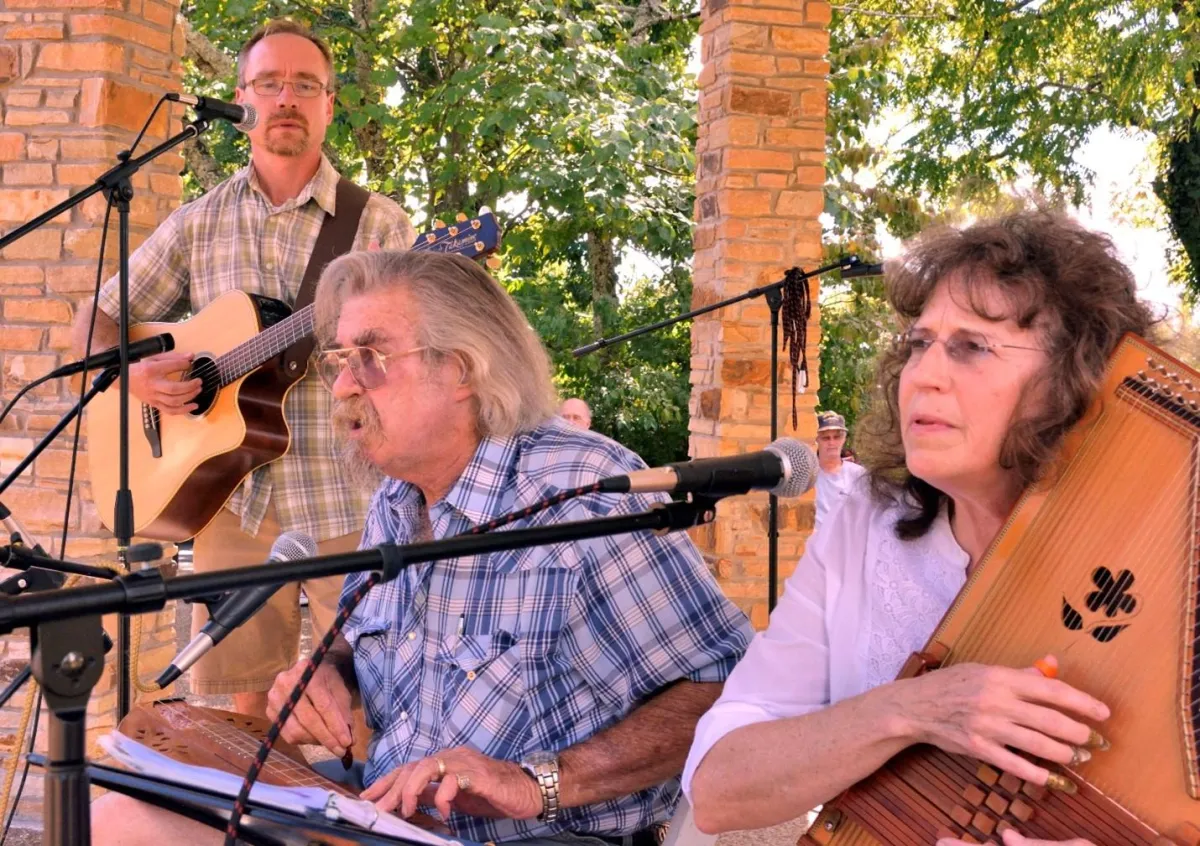
Former HTMA president Wayne Taylor [August 18, 1944-March 15, 2021] playing with other members at a Gazebo concert
Then came 1989. Wayne Taylor proposed trying to strike up the old HAFM. I felt it a useless effort. After all, Emily and Nancy Van Valkenburg had tried to restart the association earlier, with no success. But Wayne can be very persuasive as well as persistent. So, in March of that year, Wayne and I met with ~ three former members and planned the rebirth. We contacted, by telephone or otherwise, at least thirty old members, plus some whom we suspected would be interested. There are thirty names crossed out on my list, but I know of several more.
April 20, 1989 was the big day. At least twenty persons attended. Temporary officers were elected. They were; Wayne Taylor, president; Terry Burcham, vice president; Bill McCampbell, secretary; Bob White, treasurer. I do not have a list of those who were at the organizational meeting, but I do have a list of the members as of August 1989. You may well recognize some of the names. There were Pat Lewis, Bill Adams, Bob Barnes, Terry and Sara Burcham, Lew Koch, Brooks Moore, Harlace Scott, Bob & Kathy White, Damon Nolin, Aunt Bertha Robinson, James C. (Jim) Smith , and, of course, Bill McCampbell.
In the first year, there were several out-of-town members who were very helpful to us. They included Robbie Robbins of Decatur, Virginia Payne of Gadsden, Herb Cambron of Grant, Alabama, Delaine Chafin of Waterloo, Alabama, Becky Ferguson of Killen, Alabama, and Martha Jean Crain of Dolomite. I might mention too, that we again, for some reason, had the support of the Huntsville papers, the music stores (especially Fret Shop) and public radio WLRH. Even the local commercial stations would run our notices freely in their public service segments.
September of that year found us doing a very successful members’ concert at Lions Park in Meridianville. We started playing at a nursing home, now Windsor, one Friday night each month. On occasion we played at Wyndham Park and Presbyterian Apartments (for seniors). In December, we staged a concert at the UAH student center cafeteria. Monthly meetings were changed from Lions Park to the Huntsville Public Library. We set up the third Sunday in July for our annual members’ concert.

Former HTMA President Ken Hinkle [November 26, 1938 - August 8, 2021]
In early 1990, we gained some highly valued members, including Enos Yeager of Lincoln County, Ken Hinkle of Madison, Archie & Ann Lee of Red Bay, Kim Caulfield with her dulcimer, singing voice and Irish harp, and last but not least, John Ferguson (Riverboat John) then of Gadsden. John came with us in 1991 and attended practically every meeting and every special engagement, until he went away and went professional. John was back to do a Coffeehouse concert for us in fall 2000.
It may be that our early triumphs depended partly on our lack of organization and absolute zero formality. No constitution and no bylaws. Essentially, business, which is kept to a minimum at meetings, is carried on by whoever happens to be at a meeting. Members, that is. Another factor is our diversity.
At times we have had accordions, tin whistles, recorders, Irish harps, banjos, harmonicas, ukuleles, hammer and lap dulcimers, harmonicas, Jews harps, gut-buckets, and even mouth bows. Music has covered a wide range of traditional and folk music, and even stretched the definitions a bit.
There have been old time ballads, gospel, spirituals, sacred harp, cowboy songs, new Nashville, sea shanties, hillbilly, blue grass and such, up to and including near-classical. Presidents have been Wayne Taylor, Tauna Moorehead, McCampbell, Ken Hinkle, Herman Garrett, Joe Berry, Jack Ellis, and our current Jerry LeCroy. I believe that is all.
I have spoken mainly of the old HAFM up to now. There was a time we went By Tennessee Valley Association Of Folk, Traditional And Old Time Musicians; but then we changed to Huntsville Traditional Music Association (HTMA), which we judged to be more descriptive of our doings and easier to handle.
I would like to be able to tell you, blow by blow, the events we have engaged in since 1989. However, they have been too numerous for that. Besides, records are not complete. I will, however, tell you of some of the events for which we have played or may have staged.
One is Panoply, even when it was called just "Arts in the Park." I know that the Wade Mountain Wanderers, with Wayne Taylor and Tauna Moorehead, were regulars for years. Lew Koch and the Legends were there several times. We played at festivals and fund-raisers at Falls Mill Park & Museum on several occasions. Park Place fund raisers. We played at the fern sale at Botanical garden. Fund-raiser for an Anglican Church charity. Entertainment for several health care facilities, including Wyndham Park, Tut Fann veterans home, Big Springs Specialty Center, Atria, Westside Manor, Agape Village, Agape Manor, Greystone Retirement Facility, Cogburn Nursing Facility, Presbyterian Apartments. . Get the idea? Many of these we have visited in the year 2000.
My desire was--and is--to give you a little summary, month by month, of our activities in the year 2000. When I get more info together, I will try to add some more.
Bill McCampbell
2001
Update for 2001-2022 by Jerry LeCroy
Bill tells a pretty good story with lots of names of members and musicians. My memory for names is no match for Bill’s.
As Bill notes above, the association was reincarnated in March 1989, with Wayne Taylor as the new president and Bill McCampbell as secretary. Tauna Moorehead became president at the first election that October.
One of the first things Bill did as Secretary was to sign a letter-of-agreement with the Huntsville Library to allow use of the then-new library auditorium for meetings. Up to that time meetings had been held in the Lion’s Club park. Maybe the musicians preferred to move indoors for the winter months. Pat Lewis, treasurer, listed thirty-nine dues-paid members that year. Dues were $10/year.
In 1991, Tauna Moorehead was still President of what was then called the Tennessee Valley Association of Folk, Traditional, and Old Time Musicians . The association put on a concert at UAH that October, featuring Bill Adams, John Ferguson, Ken Hinkle, Lew Koch, Sarah Curtis, Rusty Hayes, Bill McCampbell, Wayne Taylor, James Smith, Harlace Scott, Brooks Moore, and Ray Anerton. Tickets were $2! I think the next president elected after Tauna was Bill McCampbell, followed by Ken Hinkle. Each served two years. Herman (Levi) Garrett was president when I first joined in 1994, and Levi served that year and the next. I was drafted in 1996. As I recall, Levi, Bill, and Ken cornered me and said “you’ve got to take it, it’s your turn.” Little did I know where that would lead.
Under Mr. Bill’s guidance the association became pretty active in the Huntsville community, playing at half a dozen events each year. Ken Hinkle and Herman Garrett continued that pattern. I think in 1992 the association began appearing every year at the Panoply festival. Members also played at the Far Out Farm, Artisan of the Month Days at Falls Mill, and the Lynchburg TN Music Festival. Fourteen (!!) members performed at the annual association Music on the Mountain in July 1992. That was a large fraction of the total membership, which at that time was about forty.
Meeting Migrations
For most of the mid 90s HTMA continued to have general membership meetings/jam sessions in the Huntsville Library auditorium. Shortly after I became president library management decided that they no longer cared to sponsor musical groups, and we were left to wander. After a month or so HTMA secretary Shelley Heard was able to work out an arrangement for us to hold meetings in what was then the main building of the Huntsville Botanical Gardens. My recollection is that we paid a token amount ($30??) each time we used HBG meeting space. While that was a token rent, paying for the meeting space absorbed over half of our annual Association budget! We also produced a day-long music festival at HBG each year, in support of the Fern Festival. HTMA’s friend and terrific guitar player (who’s name I have since forgotten) managed the Fern Festival, and we had a pretty good time at those gigs. We played shows every year for the Burritt Sorghum Festival, for Burritt Volunteer Day, and others.
I believe that HTMA held monthly member meetings at the Botanical Gardens, and put on outdoor concerts there, for nearly five years. We apparently wore out our welcome, and HBG management told us that they would no longer host our meetings. My recollection is that they decided to limit use of HBG facilities to garden clubs or others who were directly aligned with the Garden’s interests. HTMA and six or seven other organizations found ourselves ejected from the Garden, just like Adam and Eve.
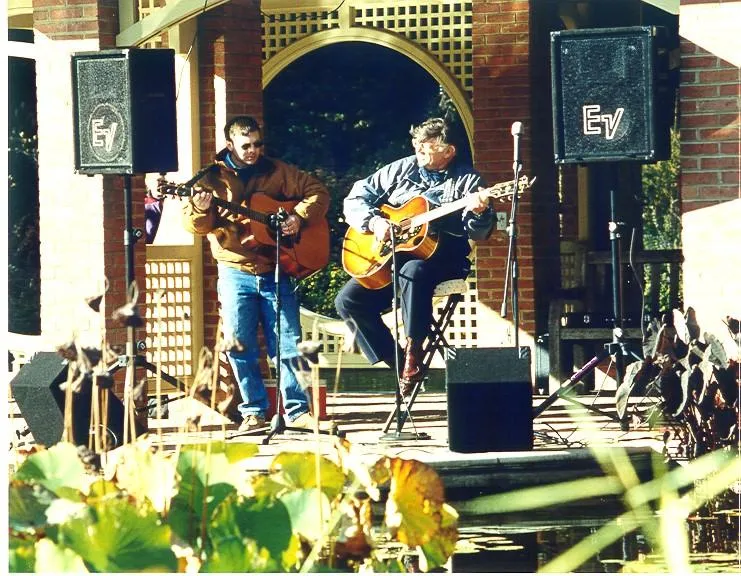
Jim Holland and Ken Hinkle playing a show at the Huntsville
Botanical Gardens in 2001
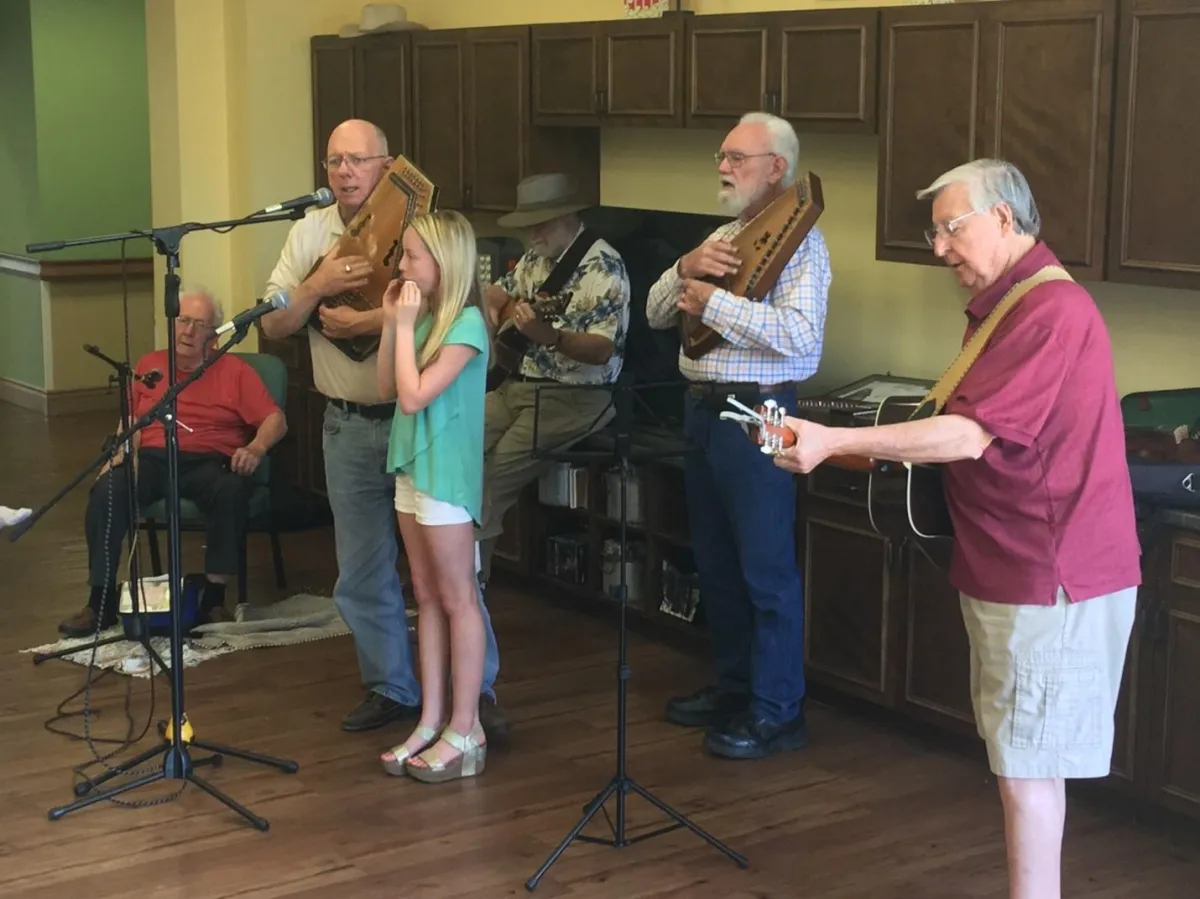
HTMA members playing in 2019 at the Regency nursing home. L-R Collier Rawls, James Smith, James’ grandaughter Reese, Jerry LeCroy, Jim England, and Barney Harding
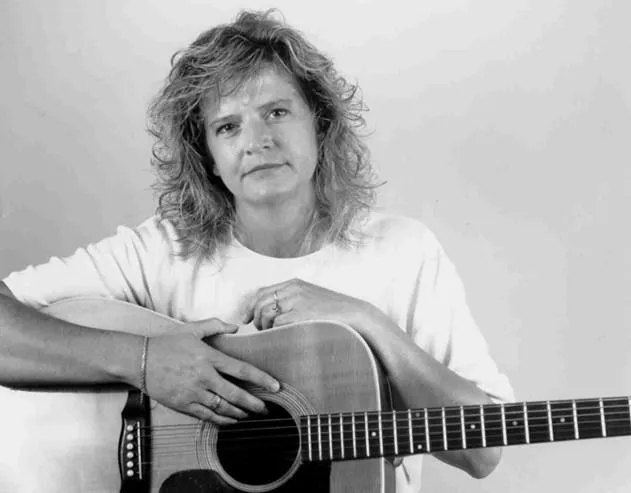
Lisa Busler, star of HTMA's first big concert
After meeting a for six months or so at random places, including a few times at my house, we were able to schedule regular meetings at a meeting room at the then-new Southeast Library branch on Bailey Cove. We met there until we were able, under new management at the Library, to get back into meeting back in the auditorium at the Huntsville main library.
About that time, former president Bill McCampbell asked me if it would be okay for him to schedule HTMA players to perform at area retirement homes. I accepted that proposal with enthusiasm. Bill would usually schedule us for three Saturdays a month, and we had a great turnout, often a half dozen or more players at every event.
When Bill passed on in 2010, HTMA vice president Jim England picked up that work and kept us all playing every month, until the COVID pandemic made in-person visits to retirement facilities impossible in March 2020. I think that as this is written in late 2022 we are looking for a brave volunteer to take up that activity again. Jim England has been covered up with caring for his lovely wife Martha, and just can’t do the booking (and carrying sound gear) like he used to when he was only seventy five. [Sadly, since this was written Martha England passed in October 2022.]
Concerts!
For previous performance gigs, Levi had hired an HTMA member, IIRC Damon Nolin, to run sound with PA gear that Damon supplied. When I became
president I decided that any administration should set some stretch goals, and my stretch goal would be to develop funding and invest in PA equipment to use producing association performances and concerts. That was good and bad.
The good part was that we fairly quickly obtained sponsors and developed a reasonable budget to buy basic (if used) sound gear. The bad part was that a number of our members took strong exception to the Association having anything to do with amplification. It was almost a religious schism. I think over a third of our membership quit that year, principally over the amplification issue. That exodus reduced HTMA’s membership to about two dozen.
But we moved on. In June 1996 we took delivery of our very first PA amplifier, speakers, mixer, and microphones. In August of that year we put on first HTMA-sponsored concert that I am aware of which featured paid outside talent. That concert, at the UAH School of Music Roberts Recital Hall, featured songwriter Lisa Busler. It was a big success. The HTMA board decided to make sponsoring an annual concert a core mission for HTMA.
Along the way that year, we had a naming competition, and changed the official name from Tennessee Valley Association of Folk, Traditional, and Old Time Musicians (quite a mouthful) to the Huntsville Traditional Music Association. I am not sure who proposed the winning name, but there were four or five options offered, and the membership chose the one that has stayed with us.
The following year (1997) our big concert featured Diane Craig and her Summer Moon Quartet . Diane had a big fan base and we sold out Roberts Hall. In 1998 we repeated that success with a concert featuring Windham Hill recording artist and songwriter Pierce Pettis, who came all the way from Mentone Alabama. We were on a roll! Steve McGehee was the VP at that time, and had met Pierce at a festival and convinced him to come do a show in Huntsville.
In 1999 the HTMA concert featured Jim Connor, who was at that time just returned from a reunion tour with the New Kingston Trio. I think Jim was making more than ten times what HTMA was able to pay every show he did with the NKT, but he put on a great act and I know I was astounded at what he could do on stage with one guy and a banjo.
These concerts were somewhat stressful for the HTMA production crew, in several respects. Every concert had many moving parts. Contract with artist, rental of venue, printing tickets and programs, selling program ads, arranging volunteers to collect tickets and putting tickets out for sale. Then day-of-show setting up sound gear that we knew very little about to actually run the concert. And always the worry that we might fall way short and lose a ton of money on the gig. In those years the HTMA bank balance seldom reached $1,000. I recall that Shelley Heard and I both personally guaranteed to make up any losses on the concerts we sponsored, so we definitely had skin in the game.
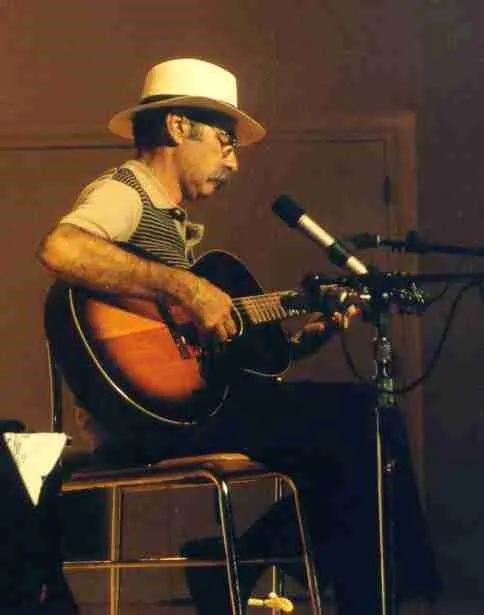
Roy Bookbinder, playing an HTMA concert at Roberts Recital Hall
One of my long-time personal goals had been to sponsor a concert with bluesman Roy BookBinder, and we accomplished that goal that in 2000, and again a few years later. Roy’s show at Roberts Recital Hall was another near sellout. However, fate was working against us. By 2001, the UAH music school had grown to the point that the Recital Hall was almost continuously booked with student performances. I think that 2000 was the last year we were able to reserve the Recital Hall venue to do a show there. We recorded Roy’s performance on a cassette recorder. I still like that tape more than any of Roy’s commercial recordings.
We took a big step up, from the 200-seat recital hall to renting Chan Auditorium at the UAH Business School. Chan seats about 430. Over the next several years we produced shows at Chan featuring Bruce Molsky, Kate Campbell, Orrin Star, The Walker Street Opry, and Norman Blake. The Norman Blake show, in March 2002, came out shortly after the Oh Brother Where Art Thou movie was released. The movie was a hit, and so the Blake show was SRO, a first for HTMA. Norman and Nancy Blake had been separated for about six years, but decided to get back together. I think that show was the first time that Norman and Nancy played together on stage since they had separated. But boy was that a scary show! We were using house sound as provide by Roberts Audio Services.
During setup we found out that several of the house audio cables that were supposed to connect microphones from the stage to the control booth were either cut, shorted, or noisy. Those cables ran in a tunnel under the floor – there was no fixing them. Then we had terrible feedback issues with the very pricy condenser microphones that Shelley Heard had brought for us to use. We had planned a sound check at two hours before show time, but still didn’t have working sound at 30 minutes till. Shelley and I were sweating bullets, and Norman was distinctly unhappy. Norman said “Just give me two SM57s, one for vocal and one for guitar”. That’s what he was used to performing with, and we made the switch. It was all working about five minutes before we let the audience in. Holy Cow!
When I paid Norman after the show he stared at the check for about a minute, like there was something wrong. Then he looked at me and said “This is for a lot more than the guarantee, Jerry.” It was, because we paid Norman a large share of the gate over the guarantee. Norman and Nancy also sold a ton of CDs and other merch – they were very happy when it was all said and done. My blood pressure went down a day or two later. Norman’s payment was in line with the HTMA philosophy then and now, to keep our production expenses as low as possible and pay as much as we could to the artists featured in HTMA performances.
After the Norman Blake gig the price to rent Chan Auditorium went up sharply, and became pretty much out of reach for HTMA. It wasn’t just the rent. New contract terms required presenters to use the UAH sound technician and pay his fee, and to hire a couple off-duty police officers and pay their wages. For our little music club, it just got to be too much. But we did several more concerts at the Unitarian Universalist church on the mountain, and also several times rented a hall way out on Winchester Road that was owned by Bobby Green, who had become a friend and supporter to HTMA. The biggest show we did featured John McCutcheon, and for that we rented a large hall at the Methodist Church. Around that time HTMA was up to about eighty dues-paying members, and it felt like we might continue to grow.
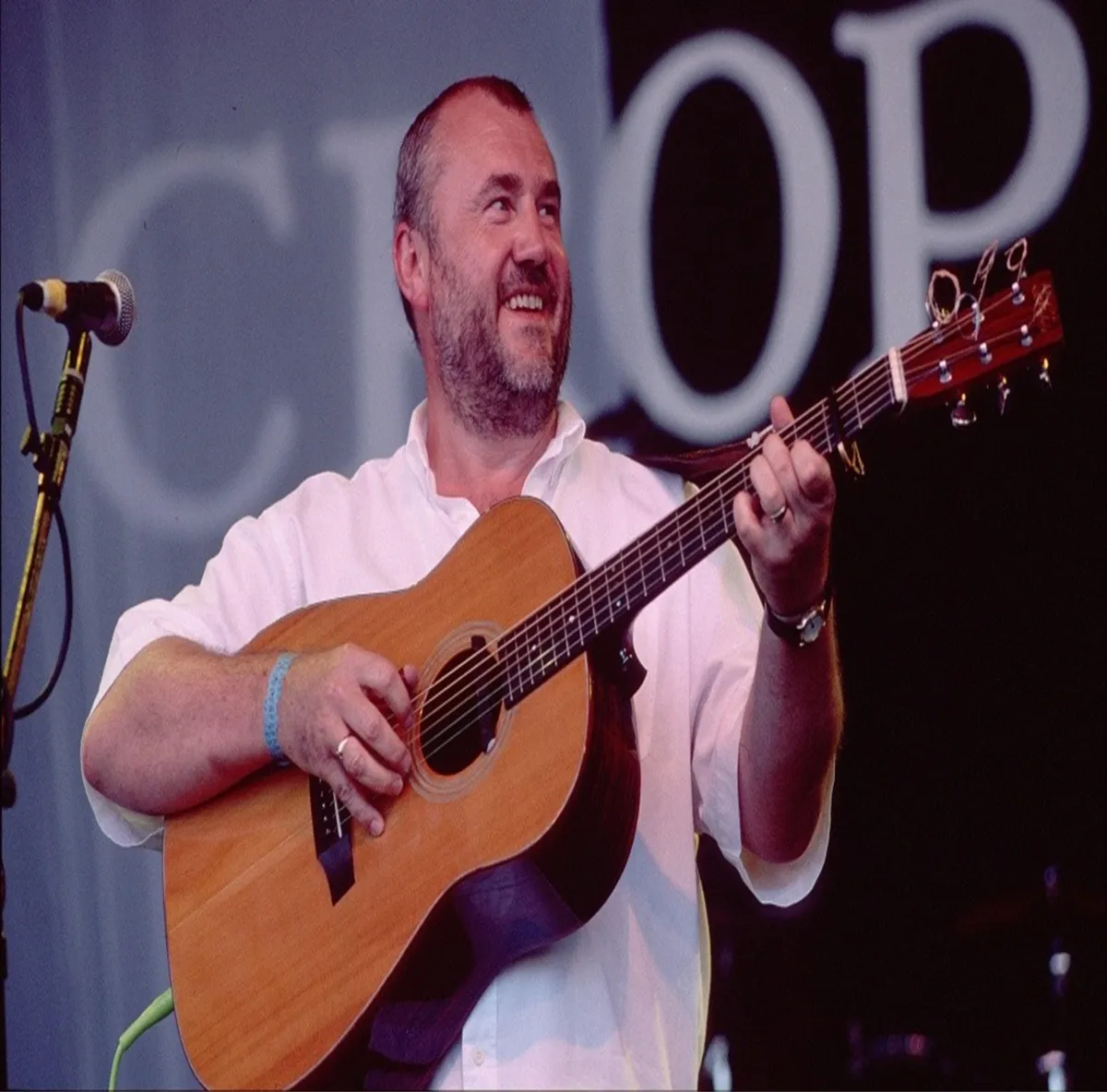
British folksinger Bob Fox at an HTMA concert
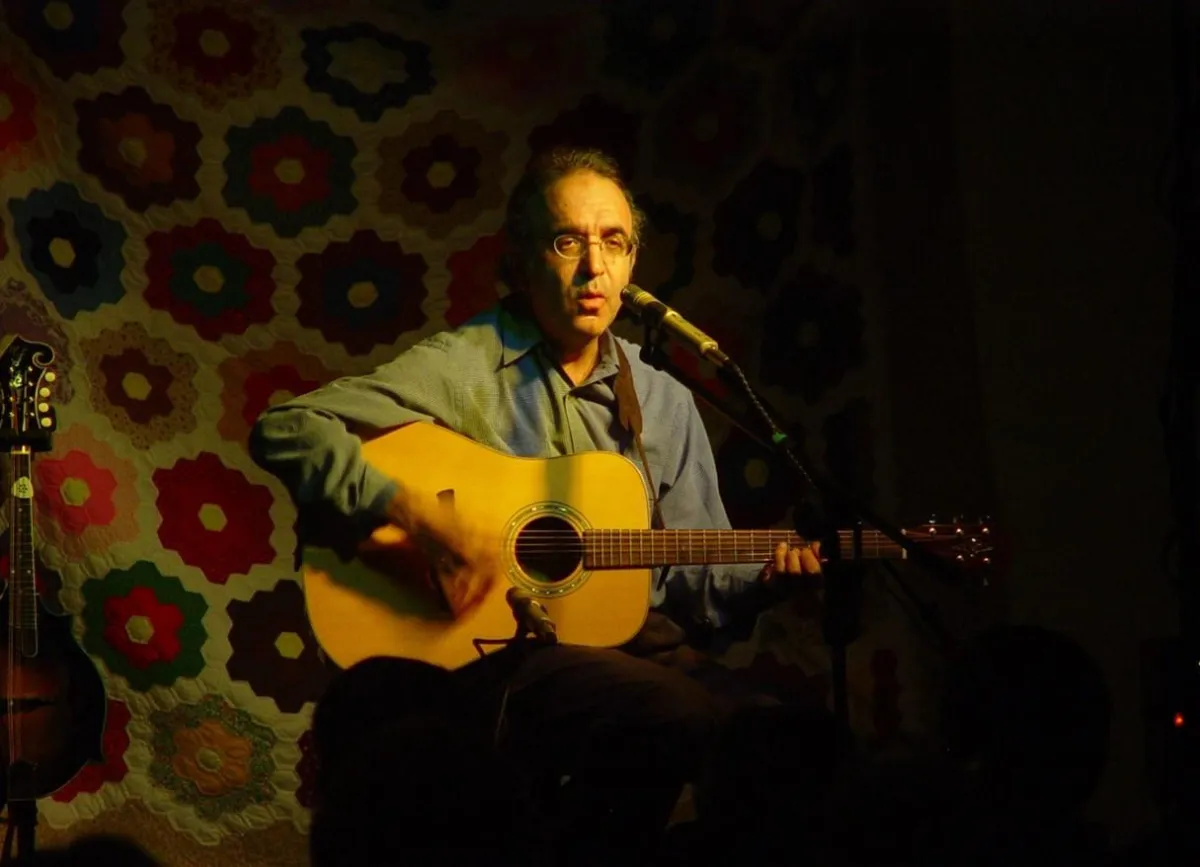
Orrin Star playing an HTMA concert in 2010
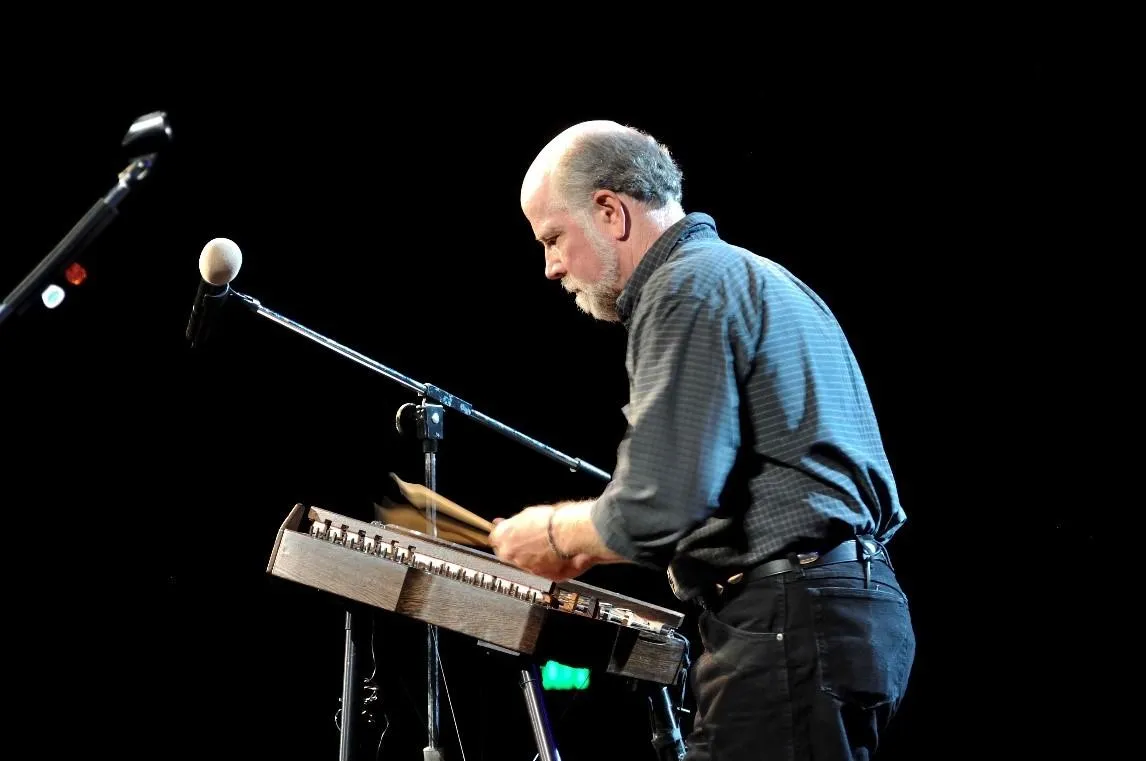
John McCutcheon at an HTMA concert in 2009
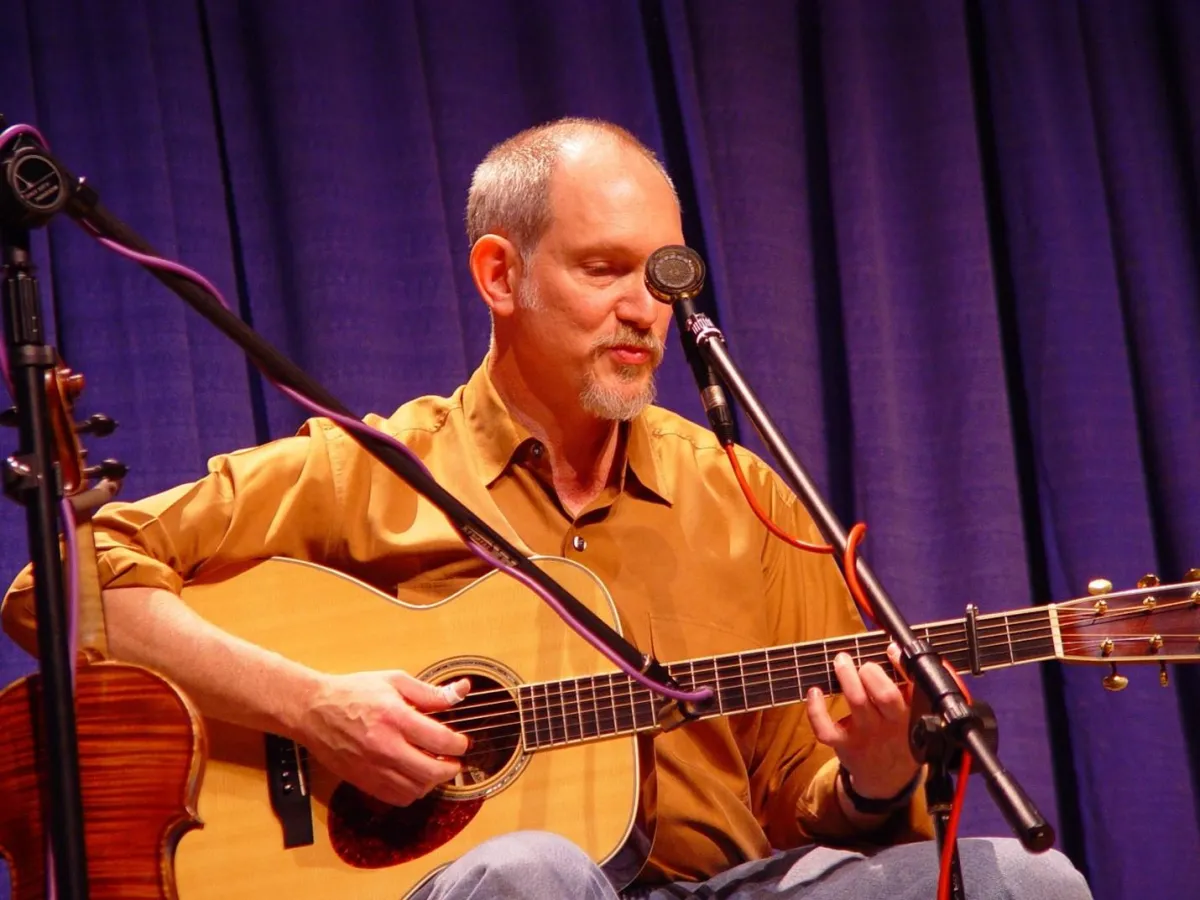
Bruce Molsky playing an HTMA concert at Chan Auditorium in 2004
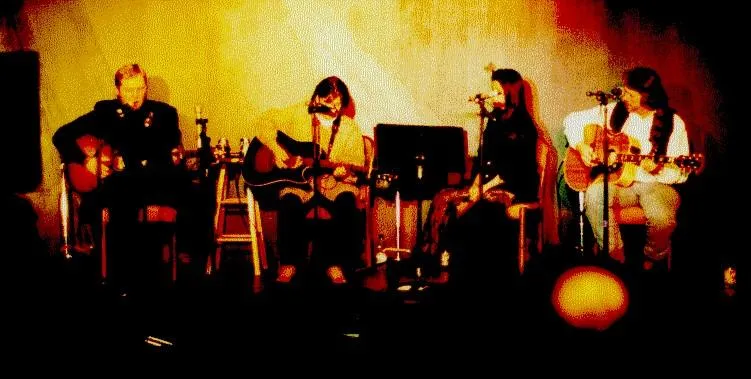
Sugarfoot, with Davis Raines, Tricia Walker, and Larry Mitchell playing at an HTMA Coffeehouse in 2001.
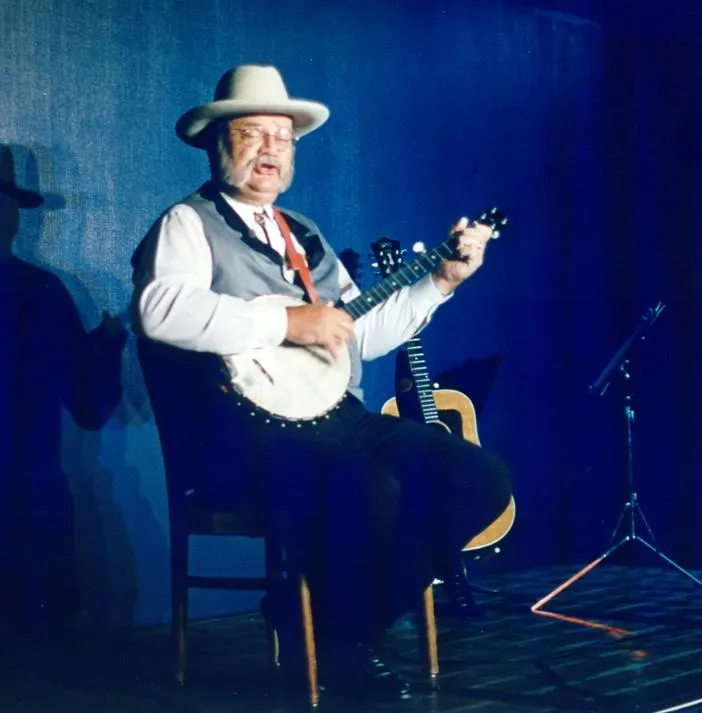
Riverboat John Ferguson playing an HTMA Coffeehouse in 2001
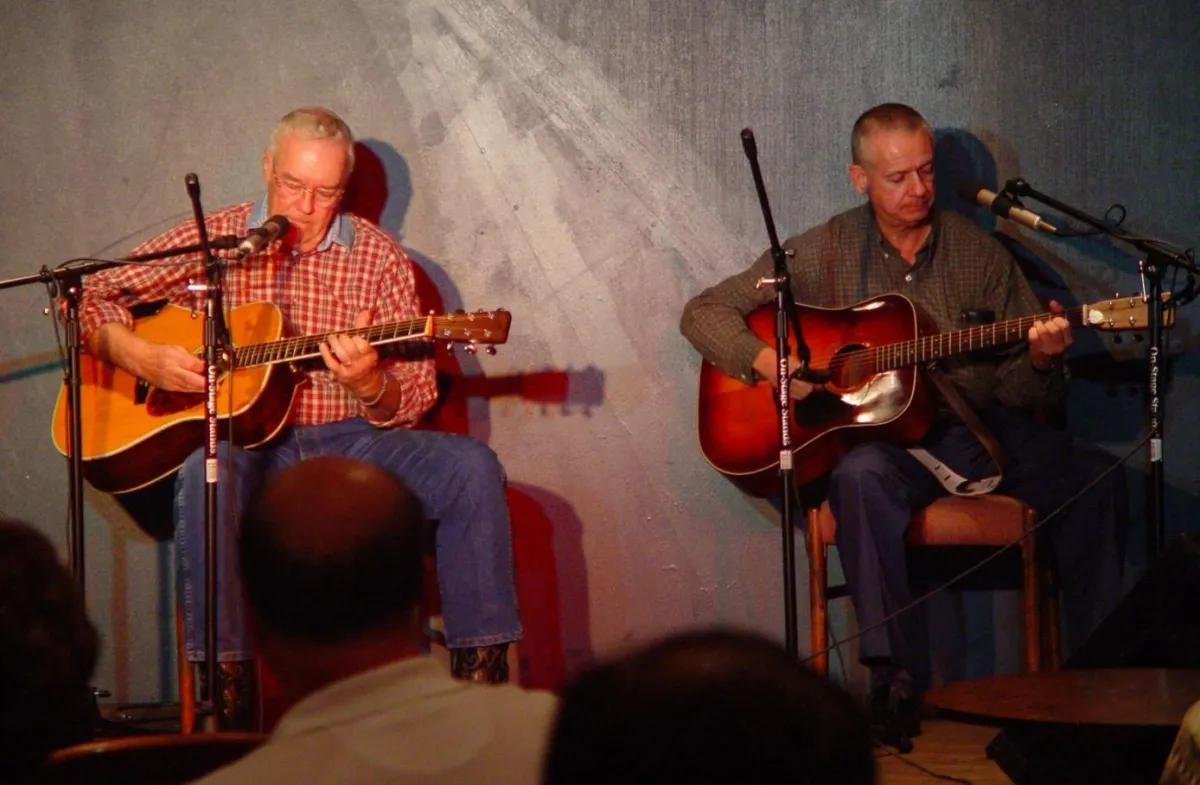
Lou Beasley (left) and Bobby Blackburn at an HTMA Coffeehouse at the UAH Student Center in 2002. Lou served as HTMA Program chair for four years.
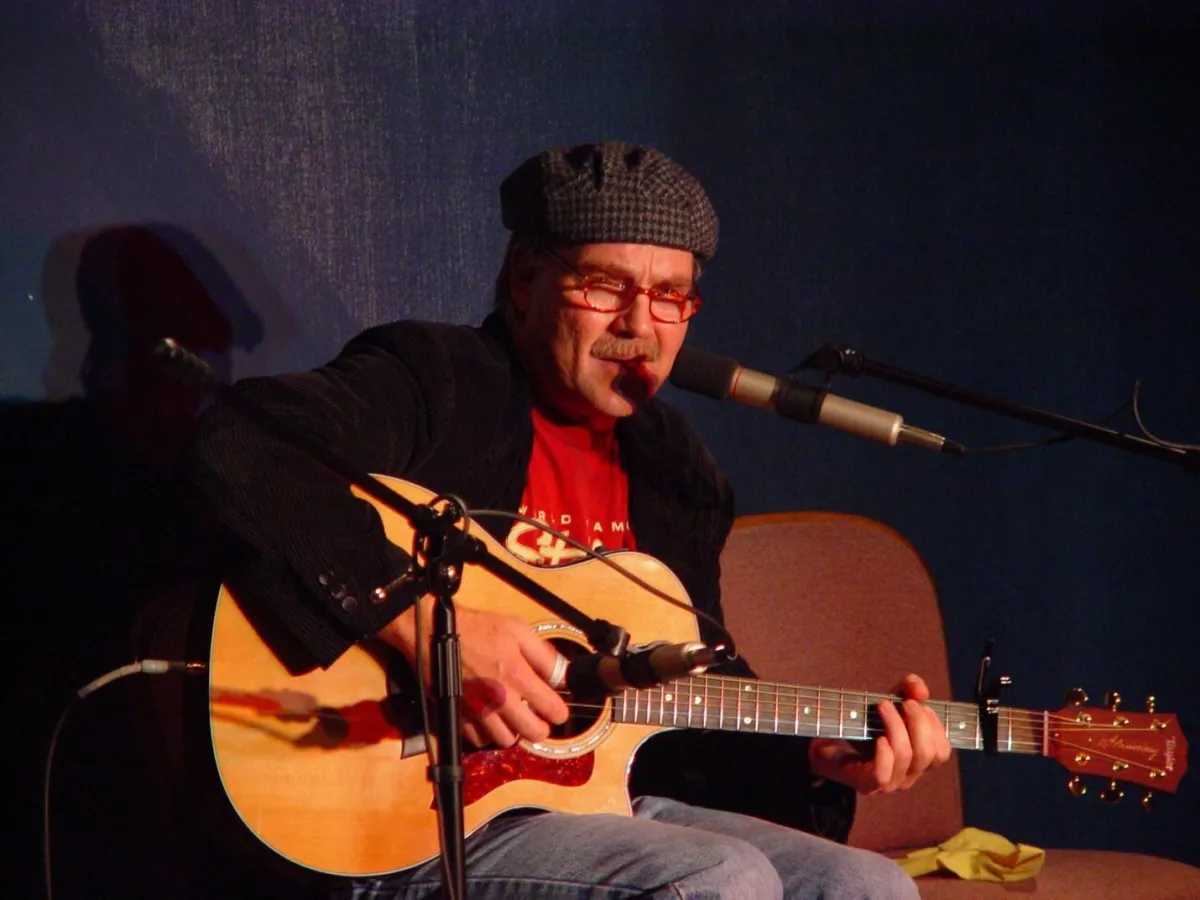
Bob Hinds playing at a 2002 HTMA Coffeehouse
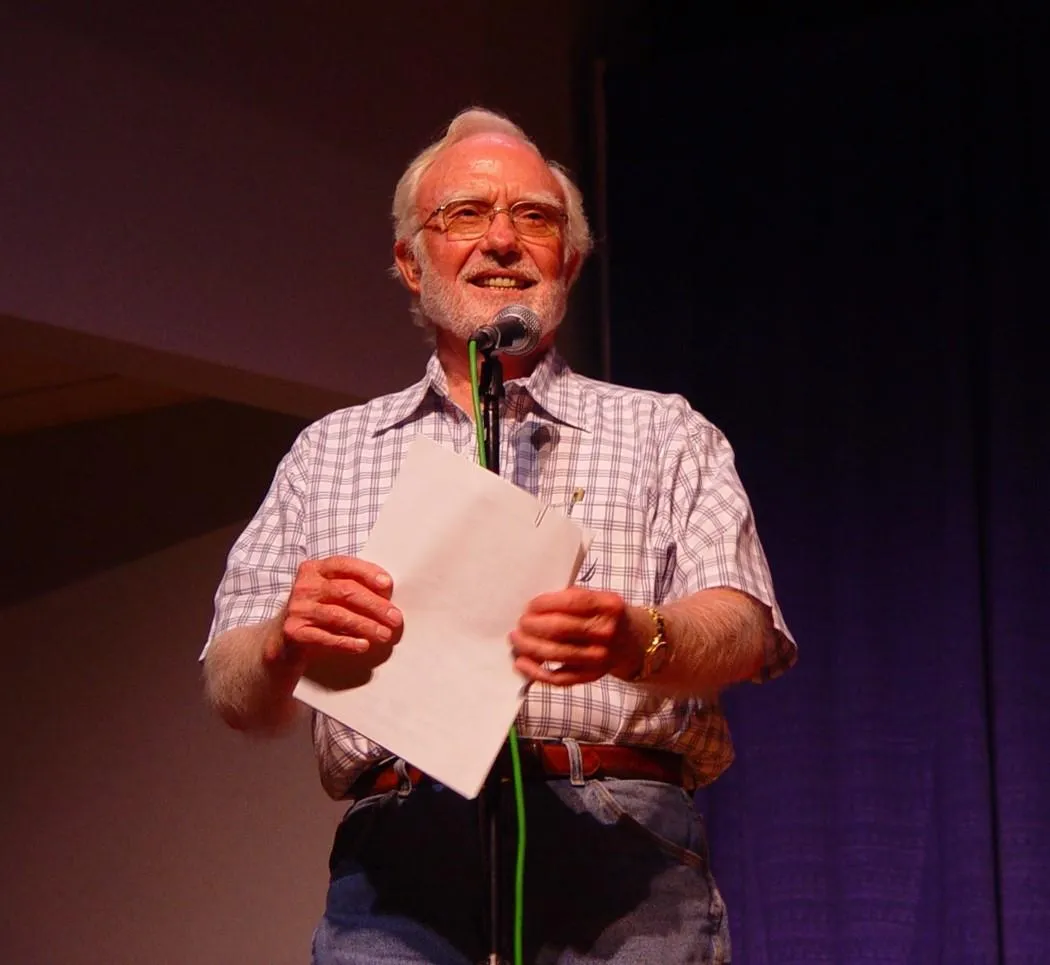
HTMA President Joe Berry making announcements at a concert featuring Bruce Molsky in 2004
The McCutcheon show was a big step up for HTMA both in terms of our financial guarantee to the artist, and the combination of hall rental and sound production fees (we had to use the Church’s production team) were twice as much as we had ever paid previously. And I was really worried about ticket sales. I had seen John M play a concert in Chan Auditorium four or five years before that. UAH was the concert sponsor, and tickets were cheap, $8 if I remember correctly, but FREE for any UAH student with a student ID. I went to that show expecting a packed house. Chan seats about 430, and there were less than three dozen of us in the audience. If I recall, HTMA needed to sell at least 220 tickets to break even when we produced the John McCutcheon, and the finances ran very close.
Producing these concerts took an enormous amount of effort from the concert production volunteers, and several key players started backing off. I think that the concert work was just wearing people out. We moved downscale to doing smaller gigs at smaller venues. Performers included autoharp virtuoso Bryan Bowers, remarkable flat-pick guitar player Beppe Gambetta, outstanding guitarist Kerry Kean, British singer Bob Fox, and mandolin player Peter Ostrousko. Most of these performers came back to do another show after a year or so. But our audiences seemed to be shrinking.
Maybe we were getting lazy about publicity, or maybe the Huntsville music market was starting to offer other performance options to the public. I don’t know. I’m certain that weather was a factor at some shows. I recall our last show with Roy BookBinder when Huntsville was under a tornado watch, and only a half dozen folks came out. That was an owie! For that show and the Bob Fox concert I ended up personally covering shortages. But about 2015 it became impossible to recruit a new “Concert Mommy” to be a concert production manager, and lacking the key volunteers, the HTMA concert series went dormant.
Coffeehouses
Levi Garrett continued the theme begun by Tauna Moorehead of producing HTMA concerts every six months or so. I think Levi began our annual member
performance at Burritt Museum around 1994. 1995 was my very first experience playing out on an HTMA stage, at Burritt. I followed Jim Connor, who came down from Sand Mountain to play. Jim was well known for playing banjo with the New Kingston Trio, and for writing Grandma’s Feather Bed, which John Denver turned into a hit.
Levi Garrett also got HTMA signed up to do a monthly show at the UAH Student Center, which at that time had a lovely small performance space dubbed Mom’s Coffeehouse. It was a terrific opportunity. Mom’s had permanently installed stage, lights, and sound. We paid a UAH student a very small amount of money to help with setup and to run the sound board, and were off to the races. A succession of HTMA volunteers brought in talent from all over. We got a few dollars in donations from these gigs, and all of it was really just gas money for the artists. I recall feeling successful if we managed to average as much as $3 person in donations. Happily, many of the artists we presented made more money from selling CDs and other merch than they received from performance
fees.
The winter of 2001 was a good season for the HTMA coffeehouse. We put on shows with Davis Raines, Larry Mitchell, and Tricia Walker, all from Nashville, Riverboat John Ferguson, and Lisa Busler. Every show was simply outstanding.
For the next several years we hosted a monthly coffeehouse at the UAH student center, and brought in tons of talent from as far away as Russia, with a number of fine musicians traveling down from Nashville to play on our stage. In some respects that was a golden age for the coffeehouses, a situation we would like to return to.
Around that time, UAH management required us to move the student center coffeehouse shows first from Saturday night to Friday, and then to Thursday. The move to a week night really cut
down our audience, but after about a year of Thursday night gigs UAH Student Center management decided to convert the Mom’s Coffeehouse performance venue we were renting to a hamburger grill, and we were pushed out of the student center pretty much completely. We were able to rent larger meeting spaces at the Center a couple times, but logistics were tough and acoustics tougher. Happily, Shelley Heard was able to convince folks at Burritt Museum to let us move the coffeehouse to play in the Old Church at Burritt Museum. Burritt has been an excellent partner supporting HTMA performances for nearly fifteen years, but the old church is much in demand as a wedding venue on weekends, so we have had to keep on doing mid-week gigs. That midweek performance schedule continues to be a constraint on our audience size. And as our membership ages, the drive up the mountain at night to go to a show has become daunting for many members.
Moving to the Old Church at Burritt put a certain strain on HTMA production resources. As long as we were doing gigs at the UAH student center, we were able to use student-center-supplied microphones, speakers, and lights for our performances, but that gear was no longer available. The HTMA board put together a budget, and upgraded the PA kit with a snake, stage monitors, and half a dozen more microphones and stands. In parallel with that, we invested in a small portable Fender 150 sound system which was used for the retirement home gigs. All this investment was based on the Board’s emphasis on supporting
live music performances. The intention then was to bring in artists who might not otherwise come to Huntsville, and at the same time provide an opportunity for HTMA members to play for our audiences.
At that time there were many HTMA members who found playing for the coffeehouse audiences to be fun and rewarding. I think I had fifteen to eighteen volunteers lined up to play at coffeehouses, so nobody played a coffeehouse more than once a year. That scheduling met my own bias. I had seen
organizations similar to HTMA operating in other towns, notably Cincinnati, where a few members essentially became the “house band” and outsiders or non-favored members were mostly shut out. Because of the significant member participation, HTMA was able to present a varied list of performers.
The HTMA production crew personnel evolved. For about ten years Steve McGehee toted HTMA sound gear to and from every show, and stored the gear in his garage. That ended when Steve was transferred to Shreveport, about 2005. I began schlepping the ever-increasing load of PA gear in our little truck. About that time George Williams started coming to HTMA performances and shortly after began running the sound board. George has been doing yeoman service on HTMA concerts since then, but he will be retiring from that job at the end of 2022. At this writing, HTMA is working to find a long term volunteer to fill George’s shoes.
Publicity and Internet Operations
Association management evolved as well. In late 2000 Sue Charles took the long-vacant position of Publicity Chair. In 2001 John Jendzurski succeeded Jim Holland as Treasurer. Jim moved over to be the secretary and newsletter editor. Up to around 2000, newsletter printing and mailing had been the single largest expense for the association. Every month reproduction and postage was costing nearly fifty dollars!
With the help of our first WebMaster, Jim Annerton, HTMA entered the digital age and began publishing the newsletter as an on-line document. We also benefitted greatly from Jim’s friend, pharmacist Alan Cunningham. Alan had purchased a block of web hosting space, mainly to support a website for his own church. Alan subdivided the web space he had bought and leased section to several local churches. I think for a long time HTMA was Alan’s only non-church client. We were Alan’s last client when he retired the web-hosting business in 2022, and HTMA had to go on the open market to find a home for the website.

Long time HTMA Webmistress Jeri-Ann Ray Payne
Jim Annerton maintained the HTMA website for several years, then I ran it until our hosting service would no longer support Microsoft FrontPage, which is the software I had been using to maintain our web presence. Brian Curtis took over as Webmaster in 2010, and completely re-did the website to get rid of the FrontPage extensions. Brian served as WebMaster for about five years, and then passed that job over to new volunteer Jeri Ann Ray Payne. Jeri-Ann was a terrific resource – she had just retired from running the web presence for a large corporate entity in Huntsville. Jeri-Ann kept the HTMA webpage alive for about four years, including a complete re-make to set the webpage in Adobe software. In 2018, Jeri-Ann decided that she was being called by the hills of South Dakota and moved up there, so we needed a new WebMaster, Thankfully, Chris Kidd stepped in to fill that gap, and he is still running our website at this writing.
In 2002 Chip Gulbro accepted the position of Performance Chair. Up to that time, Jim Holland and I had been doing most the coffeehouse booking, and it was great to hand that chore off to Chip, a man with many contacts in the music community and a great ear. Chip, a music teacher in Huntsville City Schools, handed the Publicity Chair job over to Lou Beasley after serving four years.
Lou had excellent contacts in the Bluegrass community, and as a result our coffeehouses developed a decided bluegrass flavor. Lou served as Performance chair until 2010, when he was succeeded by Jim Holland. Since 2010 several folks have volunteered to do our booking, including Ken Winchester, Karen Newsum, Bob Heinisch, and Alex Dietrich. Coffeehouses were suspended for 2020-21 due to Covid pandemic, and for 2022 Jani Brill and Larry Halterman agreed to be co-chairs. Jani appears poised to carry on as Performance Chair for 2023 as I write this.
In 2009, much like 2022, the HTMA newsletter editor’s job was filled by a temporary fill-in. Jim Holland found himself working out of town a lot of the time, and could not manage the coffeehouse production. I picked up the job temporarily. Then Brian Curtis did a great job with it for about five years. Since then the newsletter has lacked any permanent editor, but has been sporadically published by Jerry LeCroy.
Leadership
In 2002 John Jendzurski transferred up to a job near Washington, and Jim Holland moved back into the Treasurer spot. Pat Long succeeded Jim as Secretary. About that time the HTMA Board decided to consolidate the secretary/treasurer position.
In 2003 Joe Berry succeeded Steve McGehee as vice president. The plan was for Joe to spend a year in that position to learn the ropes and then move up to president the next year, which he did in January 2004. I felt that HTMA needed new leadership, and Joe Berry was exactly the right person at the right time. Joe took over as president for three or four years, followed by Jack Ellis, also for several years.
When Jack announced his plan to retire I re-entered the HTMA management as president from 2007 until I managed to recruit Lynne Edmondson to replace me about ten years later. Never has there been a more appreciative handover of the executive office!
HTMA evolving to a 501.c.3 non-profit
In late 2005, Pat Long and I agreed to take on an arduous job of making HTMA an IRS-registered non-profit. I felt that could devote some time to this project since Jack Ellis had agreed to serve as HTMA president. Our goal was to see the association file for incorporation as an Alabama non-profit, and then follow up with filing with the IRS for recognition as a 501.c.3 non-profit organization. Pat succeeded in having HTMA incorporated under the articles of the Alabama Non-Profit Corporation Act in August 2006. We started the IRS filing process late in 2006, and after some effort HTMA was approved as a 501.c.3 charitable organization June 8, 2008. Obtaining the IRS finding was a rocky road that involved responding to multiple requests for information from the service, and included a revision of HHTMA bylaws. I think that the bulk of the bylaw revision was to add the statement below in section 1.3 of bylaws, to definitively state that association membership was open to all. We also added a written policy on conflict of interest in response to a request from the IRS. Since IRS 501.c.3 recognition in 2008, any donations to HTMA have been tax-deductible.
Bylaws section 1.3 addition - Membership is open to all, regardless of age, race, gender, national origin, ethnicity, or religious beliefs, who agree with the objectives of HTMA and pay the required fees and dues.
Future
Looking at all this history, one has to ask “well that’s nice, but what’s the future looking like for HTMA?” In large part, that depends on you, gentle reader. For most of the last twenty years HTMA’s mean member age has gone up pretty much every year. The years the average member age didn’t increase were usually when esteemed older members passed on.
HTMA has suffered for a long time from a lack of workable ideas and effort focused on bringing in a new generation who want to be engaged with traditional and acoustic music. I’d sure like to see that change. But it appears to me that the time is ripe for a new generation of musical activists to move in and set aside the old fogies like me, bringing in fresh ideas and new music.
Nothing will make me happier than realizing that I’m really not needed at HTMA anymore, that the organization will get along just fine without me. But we need some new faces to show up, take names, and take charge. The door is open for new faces and new ideas.
I think HTMA is in reasonably good condition as a going concern going into 2023 in most respects. We have a pretty solid membership base, though that is less than 100 members. I think that 99% of the musicians we have put on stage would be delighted to come back to Huntsville for a repeat, and our audiences have largely recovered from the Covid-related hiatus. Members still like to play together and at HTMA gigs. The Association bank account is as healthy as it has ever been. We are suffering from a shortage of key volunteers, but that has been an ongoing issue as long as I remember. While it would be terrific to have a backup volunteer for each key spot, like Program Chair, or Production or Publicity, we are one-person deep in pretty much every position. And as I write this, we are missing a name to go with the critical job of
Production Chair, the person responsible for setting up gear and running sound at HTMA shows.
A lot of this history seems to be spent describing concert and coffeehouse productions. That is a reflection of my perspective on the HTMA mission. What is that mission? Well, our bylaws state:
1.2 Mission / Objectives
The primary purpose of HTMA is the support of folk music and folk musicians in north Alabama and the Tennessee valley area of the United States.
The second purpose of HTMA is the support of folk music, arts, crafts, traditions, and skills to further self-reliant life styles and folkways.
Well darn. That mission statement doesn’t actually say anything about concert performances. You have to go to the very end of the bylaws to get to anything on that. Here’s what membership voted to adopt:
2.0 Operating Principles
HTMA will operate according to the general Performance Principles set out in this section.
2.1 Why we present
HTMA sponsors music performances to further the expression and appreciation of music in our community. We wish to provide an attractive venue for folk, traditional, ethnic, and other music to be performed in our community, regardless of commercial value. We also desire to provide an outlet to present HTMA member performances.
2.2 Who we present
Our goal is to provide opportunities for HTMA to present performances by both members and non-member
performers.
2.3 Timing of Performances
HTMA is committed to supporting live music performances in monthly coffeehouse events. Other concerts and performances may be scheduled at the discretion of the Board and the Performance Chair.
2.4 Financial Principles
HTMA is committed to fair compensation for professional performers at all sponsored events. Over the long term, HTMA intent is for coffeehouse performances to have little or no net revenue for the association, so that coffeehouse revenue after expenses is applied to compensate non-member performers. Compensation for HTMA members performing in our presentations will be limited to expenses. All artist compensation is at the discretion of the Performance Committee chair and the Board.
HTMA may produce concert performances that generate revenue for the association, with income applied to help further the organization’s goals, provided that artists’ compensation at these performances meets the intent of ‘fair compensation’. As an operating goal, concert business plans will be structured to return three quarters of net revenue (after production expenses) to the performing artists.
The underlying thought behind those principles are why many members have invested huge amounts of time and effort to support concert and coffeehouse productions, and to come out for general meeting jam sessions. Should we keep on that path today? I think that decision will be made by the next generation of HTMA leaders. But we need those leaders to show up pretty soon.
501C Ruling: The IRS has recognized the Huntsville Traditional Music Association as a tax exempt non-profit corporation, under section 501.c3 of Internal Revenue Code, effective August 25, 2006. Your charitable donations to help us continue our mission of maintaining a folk and traditional music presence in the Tennessee Valley are both appreciated and tax deductible.
Copyright 2025 Huntsville Traditional Music Association All Rights Reserved.


